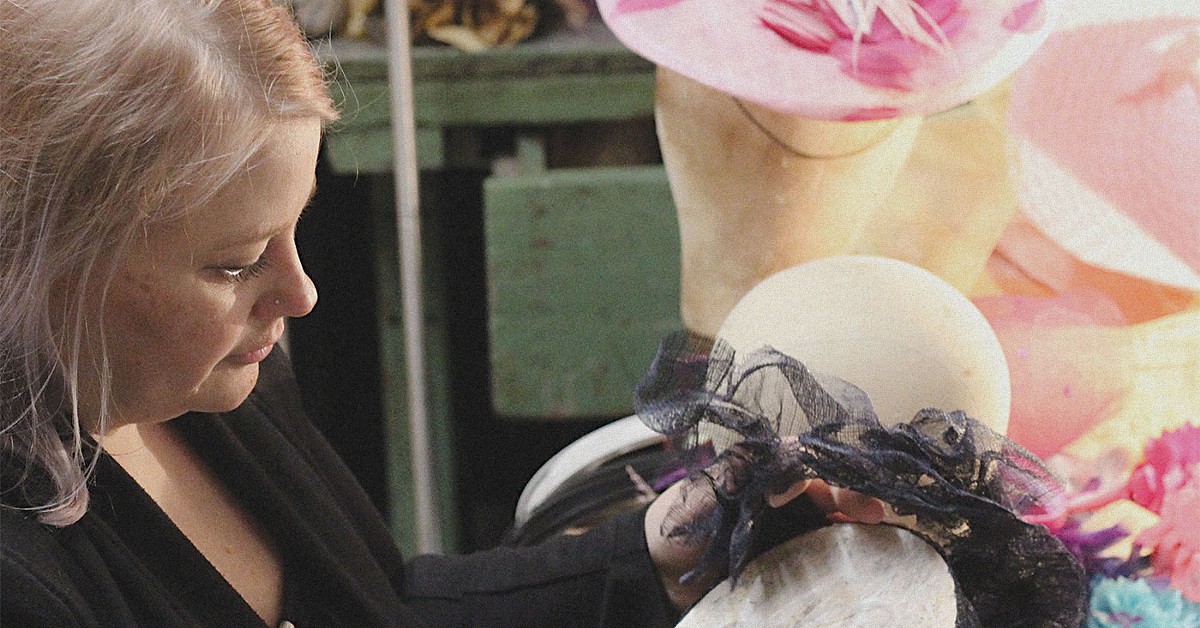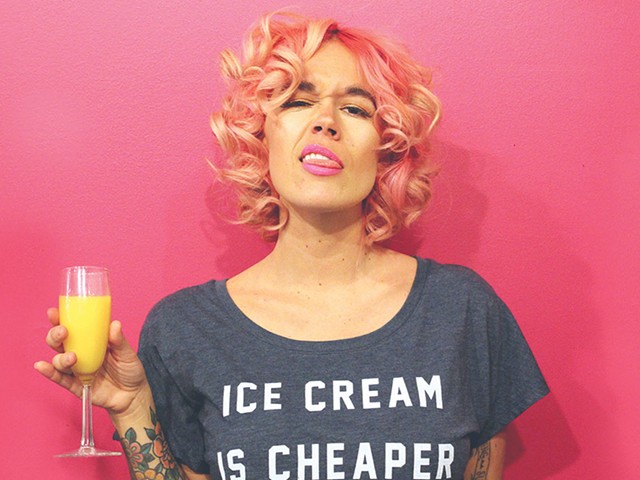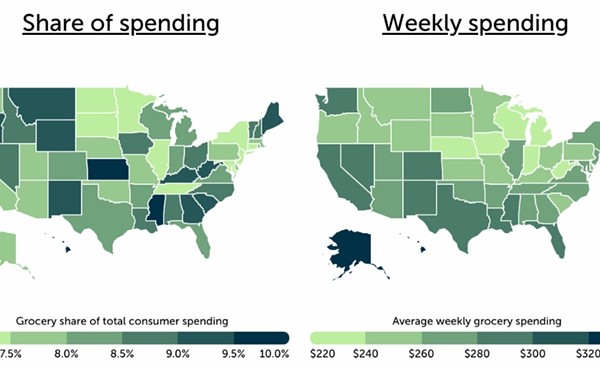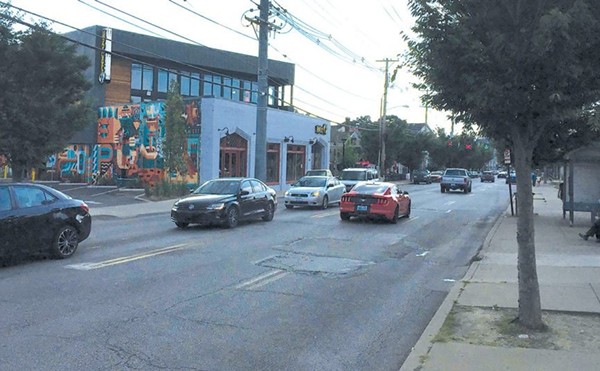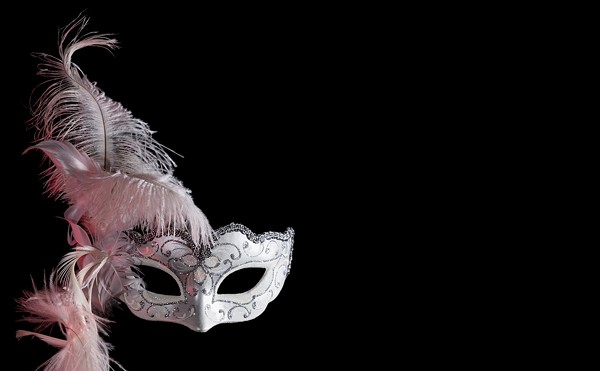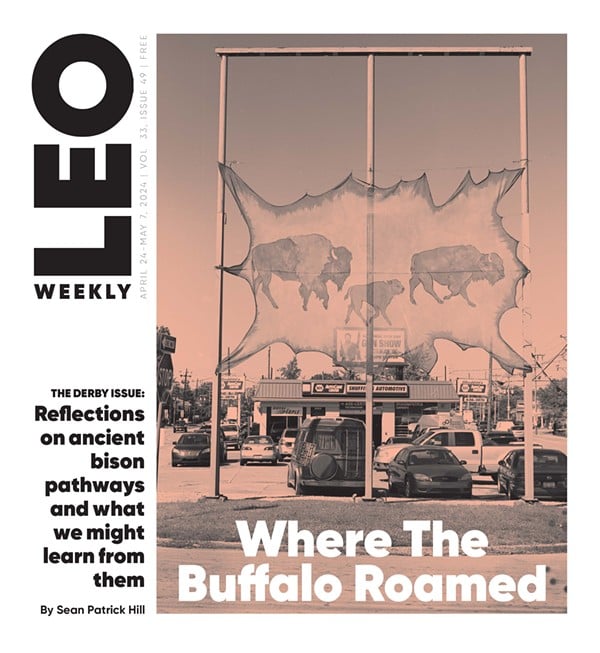“Hats are about emotion. It is all about how it makes you feel. I like hats that make the heart beat faster.” —Philip Treacy, couture hat designer
Full disclosure, I am a hat maker. I design and make men’s and women’s hats, so clearly, I have a vested interest in educating people about hats, how they are made and what makes a hat high quality and fabulous. I moved here to Louisville purely because of the opportunity of the Kentucky Derby, an event where traditionally people still wear hats. I feel compelled to write about hats not only for my own purposes, but because Louisville is home to some other fantastic milliners and designers, and I want to highlight them and their thoughts about hats, derby, and the local fashion scene.
I set off to interview Sarah Havens at the Hope Mills Building, where she was transitioning her studio from the back of the building to the front, where there are gorgeous windows facing Kentucky Street; letting the natural sunlight pour in. Sarah always had a love of making things; sewing and designing costumes. The first “hat” she recalls making as a young girl was with her brother, also a designer, when they were determined to make the tall hat featured in Dr. Suess’ “Cat in the Hat.” From there, she worked in costume shops in college, and interned with theater milliners. She enjoyed costuming as a whole, but saw that choosing hat making, specifically, helped her in consolidating her efforts and focus.
“I love how hats reflect socioeconomics, and Kentucky exemplifies that,” she said.
Truly though, since the beginning of historical clothing documentation, what you wear on your head has always been some kind of reflection of status and personality.
Of course, we quickly got to the topic of the Kentucky Derby, and how that affects our business as hat makers, and what we each have to do in order to prepare for it. “I’m not doing big wide-brimmed, picture hats for derby. I like to do 1920’s cloches; something different,” she told me.
When people ask her how long it takes to make a hat (which is an everyday question we get used to in “the Biz”), her answer is: many years. What she means by that is it can take years to incubate a design, and she takes care and time to hone in and refine them until it is exactly right before she even releases the design for the public to purchase. This process is strategic because, as she pointed out, “...there is so much risk in tying up your money in supplies and samples, just to have enough for people to choose from and see what you can make.” Hat materials are far from cheap, at least the materials we both use. Sarah uses high-quality rabbit fur felt, hand woven straws from Ecuador, fine ribbons and sweatbands. All of these components are not only expensive, but difficult to source, and they require lots of capital up front. Sarah does a lot of custom hats, and has clients who come see her for a new piece every time they come to down. “Every time I make a hat, it gets better,” she said.
Several days later, inspired by our conversation about the hat business, I went to visit Jenny Pfanenstiel, and her shop “Formé Millinery” in the Mellwood Art Center. Stepping into her shop felt like popping into a classic millinery house that I would romantically imagine to exist in 1930s Paris. Full of spring designs — bright colors, sprightly feathers and fun shapes greeted me from the hat racks floating in the center of the room. Jenny was standing behind the curved Art Deco glass counter to the right of the entrance. I got the impression that she was maybe a bit nervous about this interview, and rightfully so. I can imagine it could be a bit unnerving to have someone from your field, in essence someone who could be considered a competitor, contact you to do an interview in your own studio. I quickly tried to break the ice by genuinely complimenting her on her space and on some of the more complex pieces that were in progress in her studio. The hat world can be a bit of a private space and, in some cities, it is highly competitive. Lots of hat makers are very secretive about their techniques, tools and their space. However, I am of the belief that if you are truly a great hat maker, and a unique designer, despite all obstacles or copycats, you will continue to create unique designs, and prosper. It became clear very quickly that Jenny and I were like-minded in this mentality, and we immediately found out that we both went to school for theater arts, and have a love for theater, costume and vintage things.
Jenny told me she goes out of her way to source very unique materials and trims, especially vintage items, such as vintage straw pieces, vintage ribbons or buttons. You can’t buy these types of things at Joann’s, the only fabric store within 30 miles of all of the designers in Louisville. The materials she sources are not cheap by any means, and often she sources things from millinery supply houses in England and Australia, because hats are more popular there so there’s a better selection than domestic supply houses; plus a lot of supply houses in the United States have closed over the past 30 to 40 years.
We talked a lot about the business of being a hat maker; as Jenny pointed out: “Artists don’t realize only 20 percent of your business is making, and 80 percent is marketing.” She has definitely figured out a thing or two about PR and marketing. She has gotten a plethora of fantastic press, and recently became the official milliner of the Churchill Downs gift shop. We both moaned a bit over the lack of sewers and pattern makers locally — both of us could use an extra hand at our shops, especially during the busy derby season. “Learning how to delegate as a small business owner is crucial to success,” she said.
We concluded our interview about all things hats by talking about what goes on locally at the retail level for Derby. She expressed frustration that some hotel gift shops here in Louisville don’t carry local hat designs, or if they do, they will only carry them on consignment, even if they know that they will sell during Derby week. It’s a big risk to spread out your costly inventory at other stores, where you will make little to no profit, and still not have the guarantee of a wholesale payment, and instead have to wait for your product to sell before making back your investment in costly materials. Jenny said she thinks this mentality is starting to shift, as she is partnered up with Churchill Downs, and more people in general see the value and the difference between a high-quality piece that’s made by hand from start to finish, versus something made in China.
Jenny’s pieces range in price from $350 to $2,000, and every year she comes up with new designs. I asked her what inspires her, and she said she doesn’t really follow trends, but never struggles to come up with designs, as she has so much in her head that she dreams about creating. Her favorite way of getting inspired is working with an old hat block, something that’s 50 to 100 years old. “This may sound cheesy, but sometimes I feel like the energy of the hat makers who used the block before me comes out when I’m making the hat.” I totally get it, some of the blocks I use have the original owner’s name etched in them, some are worn from repeated use, and others have scribbled notations on the bottom. Making hats is truly an art, and I encourage you to seek out local hat makers in your city, we are... peculiar...people. •
Olivia Rose Griffin is the entrepreneur and designer behind hat and apparel store The Mysterious Rack, at 558 S. Fourth St.
Sarah Havens Millinery 1000 Swan St. 718-3121 sarahshats.com Formé Millinery 1860 Mellwood Ave., Suite #111 (773) 719-7307 formeonlineshop.com

